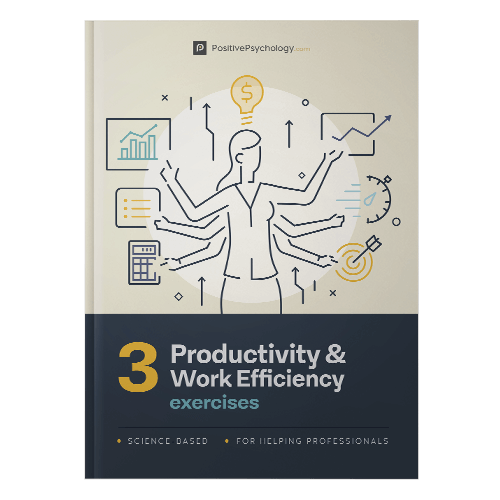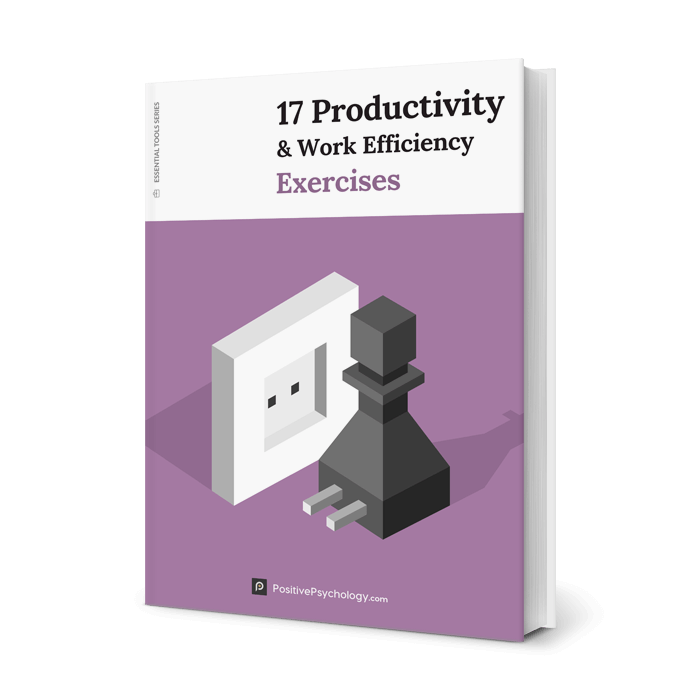5+ Ways to Boost Intrinsic Motivation in the Workplace
 Some years ago, I worked in a university library to help pay for my studies.
Some years ago, I worked in a university library to help pay for my studies.
I loved being surrounded by books and immensely enjoyed helping students find research articles and locate authors.
While my pay was small, my motivation was high.
Research has shown that being intrinsically motivated – doing something primarily for interest or enjoyment – is energizing, nurtures wellbeing, and boosts our performance (Ryan & Deci, 2017).
This article discusses intrinsic motivation in the workplace, what it means for performance, and techniques and strategies that can help nurture it.
Before you continue, we thought you might like to download our three Productivity Exercises for free. These detailed, science-based exercises will help you or your clients become more productive and efficient.
This Article Contains:
- 4 Real-Life Examples of Intrinsic Motivation in the Workplace
- How Does Intrinsic Motivation Affect Performance? 5 Findings
- Promoting Intrinsic Motivation at Work 101
- 5 Techniques & Strategies to Start Employing
- 1 Questionnaire and 2 Measures for Your Employees
- PositivePsychology.com’s Relevant Resources
- A Take-Home Message
- References
4 Real-Life Examples of Intrinsic Motivation in the Workplace
Motivation maintains, sustains, and directs human behavior over a prolonged period (Ryan & Deci, 2017).
“Intrinsic motivation involves doing a behavior because the activity itself is interesting and spontaneously satisfying” and leads to persistence (Deci & Ryan, 2008).
The following four examples highlight the importance of intrinsic motivation in the workplace:
‘Spare time’ phenomenon
Several organizations motivate their staff by giving them free time to explore something that interests them. Making time for fun projects has shown to boost workers’ sense of autonomy while also being an incredible source of innovation (Pink, 2018).
At 3M, encouraging technical staff to spend 15% of their time on projects of their choosing led to the invention of many new items, not least Post-it Notes (Pink, 2018).
Friday night experiments, as they became known at the University of Manchester, UK, resulted in the invention of graphene – a material that is currently revolutionizing the electronics industry (Discovery of graphene, 2020).
Employment programs for psychiatric patients
In an early study into work motivation, patients diagnosed with either schizophrenia or bipolar disorders were included in research into transitional employment programs (Kasser, Davey, & Ryan, 1992).
Findings showed that following training, their sense of competence, autonomy, and relatedness for the job predicted the hours they worked, the pay they received, and their readiness for employment.
American bankers
A 2004 study into a major U.S. banking corporation found that like other industries, employees were not driven by extrinsic factors such as pay and bonuses (Baard, Deci, & Ryan, 2004). This is perhaps surprising given the financial focus of the industry.
Instead, findings showed that meeting their basic psychological needs was much more important to employees’ wellness, motivation, and ultimately staff performance. Factors included feeling competent in what they were doing, connected to those they worked with, and having a degree of control over their work.
Volunteer organizations
Motivational experts Edward Deci and Richard Ryan (2017) report that the degree of engagement in tasks was also closely linked to perceived autonomy (a strong indicator of intrinsic motivation) in volunteers at an animal shelter.
Research also suggests that being autonomy oriented is a predictor for participating in volunteering.
How Does Intrinsic Motivation Affect Performance? 5 Findings

Yet, such drive is not limited to sporting achievements; it is present in any task that requires persistence.
While there are several psychological theories of motivation, the self-determination theory (SDT) has proven particularly popular, with a wealth of research confirming its ability to predict people’s behavior in multiple environments (Ryan & Deci, 2017).
According to SDT, we are driven to realize our potential and attain healthy psychological, social, and behavioral functioning because of the constant interaction between our human nature, social factors, and the environment.
Intrinsically motivated people find what they are doing to be inherently interesting and appealing. In contrast, extrinsically motivated individuals are driven by external consequences, such as financial rewards and avoiding getting into trouble or being criticized (Ryan & Deci, 2017).
Surprisingly, introducing extrinsic factors can reduce intrinsic motivation and make us feel like we have less control over the situation (Ryan & Connell, 1989).
But how does intrinsic motivation affect our performance?
Central to Deci and Ryan’s (1985) theory of motivation is the idea that there are innate and universal needs that, if met, motivate our behavior and encourage psychological and physical wellbeing.
The three basic needs are (Ryan & Deci, 2017):
- Relatedness
Our sense of belonging and feelings of connectedness to others - Autonomy
Our desire to feel free (as opposed to controlled) when making decisions in line with our interests - Competence
Our sense of being capable in what we do; also linked to our desire to learn from new experiences
Environments that help us satisfy these psychological needs enhance our intrinsic motivation and our performance.
Research has confirmed that more autonomy increases engagement and wellness within the workplace while reducing adverse effects including burnout and exhaustion (Ryan & Deci, 2017).
Besides that, intrinsic motivation – and autonomy in particular – predicts performance at work, the ability to handle change, and even our adoption of the latest technology (Moran, Diefendorff, Kim, & Liu, 2012; Mitchell, Gagné, Beaudry, & Dyer, 2012).
Promoting Intrinsic Motivation at Work 101
SDT highlights the importance of satisfying our basic psychological needs – relatedness, autonomy, and competence – at work.
Research has shown that intrinsic motivation results when “workers autonomously engage in work that they value and for which they feel respected and fairly compensated” (Ryan & Deci, 2017).
And this finding holds across all types of organizations, cultures, and roles.
So how do you promote intrinsic motivation in the workplace?
“Intrinsic rewards produce non quantifiable personal satisfaction, such as a sense of accomplishment, personal control over one’s work, and a feeling that efforts are appreciated” (Harvard Business Review, 2019).
Intrinsic rewards are not the same for everyone; they need to be tailored to the needs of the individual and might include:
- Regularly changing roles
- Attending conferences
- Learning new skills
- Time with the CEO
- Engagement in a high-profile team or project
More generally, and in line with the findings of research into intrinsic motivation and the SDT, there are several straightforward ways of promoting motivation that we can incorporate into our daily routine and, notably, the structure of the business.
These include (modified from Harvard Business Review, 2019):
- Recognizing and acknowledging good work
Recognition is more powerful than money; it makes people feel special. A company-wide 5% salary increase is well received yet impersonal.
Gratitude should be specific to the individual and take their personality and needs into account. For example, while an extrovert may welcome a call-out in front of a large group, an introvert will benefit more by being thanked over a coffee and a one-on-one chat.
- Empowering employees
We are most energized when we make the decisions that affect our work – how and when we approach it.
Giving staff autonomy shows trust and confidence and recognizes the value of their contributions. It also boosts their sense of ownership, engagement, and ultimately their overall motivation.
- Providing employees with challenges
Humans thrive on challenges, and we are often more capable than we, or indeed our managers, realize.
The greatest rewards also come from overcoming something that pushes our limits. Little is gained by facing the same challenges day in and day out.
Stretch employees with novel and more challenging pieces of work, and engage them with more complex clients.
Keep in mind the three basic psychological needs – relatedness, autonomy, and competence – and think of ways they can be met that grow people’s potential.
5 Techniques & Strategies to Start Employing

Avoid poor management
Ron Carucci (2019) outlines what not to do when motivating your team.
When engaging with your staff as a manager, avoid (modified from Carucci, 2019):
- Drive-by praise
Shouting to the team as you walk past (or even worse, sending a text), saying something like “great job, keep it up,” has no value and may even damage morale. Instead, be personal, deliberate, and specific with your praise. - Insincerity or not telling the truth
Praise has to be honest and communicated openly. - Guilt gratitude
Being a poor manager and mistreating staff cannot be offset by making appreciative comments driven by guilt. - Not knowing the story
Saying thanks without knowing what the individual or team did is inauthentic. Ask them to explain the story behind their actions. - Failure to share the context
If you don’t explain how the added value positively affects the company, staff will never connect their daily actions to company performance. - Ignorance of the cost
If the team has been putting in extra time or working unsociable hours, recognize the cost to them and those they hold close.
Recognize individual needs
Satisfying psychological needs to reach optimal performance must be specific to each member of staff.
“Stop treating them like clones,” says Natalie Baumgartner (2019).
Baumgartner (2019) writes that a survey performed by her company looked at 763 million one-to-one relationships (note: each person will have multiple connections) and found that only three people had the same 18 personal values (Baumgartner, 2019).
We are all unique.
Get to know your team. Understand what is important in their lives. Being available to drop the children off at school, finishing early on a Friday to meet with friends, working abroad, and learning new skills are all equally valid.
Recognize and use strengths
Strengths define who we are and what others see. When we are given the opportunity to use them, we are happier, more connected, and perform better (Niemiec & McGrath, 2019).
Ask employees to complete a strengths-finding test as a way of ensuring that their talents are used and they have an opportunity to thrive. We should aim to “find out what makes them unique and create meaningful processes to help them be their best” (Baumgartner, 2019).
Show people their work matters
When John F. Kennedy asked a cleaner at NASA what his job was, he replied, “I’m helping to put a man on the moon” (Garrad & Chamorro-Premuzi, 2019).
With the right mindset and exemplary leadership, all jobs can have meaning.
Having a leader with the following characteristics can help (Garrad & Chamorro-Premuzi, 2019):
- Curious leaders are better at finding people engaging tasks.
- Leaders who push forward in the face of success and failure encourage their staff to reinvent, progress, and grow their careers.
- Hiring individuals with values that fit the culture is crucial to success.
Engage in flow
According to Mihaly Csikszentmihalyi (2009), a state of flow at work is found in the equilibrium between our perceived skills and real-world task difficulty.
If achieved, we produce our very best work and maintain a state of optimal performance.
Surprisingly, it doesn’t matter if the task is mundane or highly complex, so long as we ensure:
- We are fully engaged and working toward a clear set of goals.
- We receive regular, clear feedback that enables us to fine-tune our actions continually.
- We maintain the balance between perceived skills and the actual ones required.
Those who are more able to enter this state and have developed an autotelic personality either change “constraints into opportunities for expressing their freedom or creativity” or transform the job itself into one more conducive for flow (Csikszentmihalyi, 2009).
Research shows that there are close links between this state of optimal performance and intrinsic motivation. Finding one may facilitate the other (Csikszentmihalyi, 2000).
1 Questionnaire and 2 Measures for Your Employees
There are several ways to measure intrinsic motivation and the factors that impact whether the individual is satisfying their psychological needs.
SDT – General Causality Orientation Scale (GCOS)
Based on the SDT, the GCOS comprises 12 vignettes (short situation descriptions) and 36 questions describing typical social, family, and work settings.
It is available for download and typically takes less than 30 minutes to complete.
The test has been widely validated and provides valuable insight into the degree of intrinsic or extrinsic motivation exhibited by the person completing the test (Deci & Ryan, 1985).
Employee engagement
Ryan Fuller (2019), writing for the Harvard Business Review, provides a set of direct measures to better understand the degree of employee engagement in an organization.
According to a Gallup poll, increased engagement can lead to up to a 20% boost in productivity (Fuller, 2019).
The following performance indicators provide direct measures of employee engagement:
- Number of hours worked outside of regular working hours
Indicates discretionary effort. - Number of connections in their network and the amount of time spent beyond the immediate team or group
Extended networks are a sign of increased engagement. - Percentage of ad hoc meetings versus planned meetings
Being involved only in structured recurring events can show low levels of engagement. - Engagement with customers and colleagues beyond the normal scope of work
Suggests the individual is sufficiently engaged to help even if they receive no credit.
It is also useful to understand what drives these engagement levels.
- Time spent in one-on-ones
Typically, employee engagement is linked to the amount of time spent with their boss. - Exposure to more senior levels
An individual’s manager can facilitate or hinder the ability to connect with colleagues further up the ladder. - Quality and breadth of manager’s network
Well-connected managers can be of significant benefit to their employees. - Percentage of manager’s time with the team
Too high or too low, and it can negatively impact engagement.
Work schedules can also speak volumes.
- Hours spent in meetings with more than 20 attendees
Large group meetings can decrease engagement, where we become nothing more than a member of the audience. - A fragmented calendar
Insufficient time between meetings to get work done is a common problem.
Employee disengagement
It is crucial to recognize the early signs that an employee is becoming disengaged from their role.
Ask yourself the following questions regarding the behavior of the staff member now compared with what was previously typical (modified from Harvard Business Review, 2019):
- Has their productivity dropped off?
- Have they begun to act less like a team player?
- Are they doing the minimum amount of work more frequently?
- Are they less interested in pleasing their manager?
- Are they less willing to commit to long-term timelines?
- Are they exhibiting an adverse change in attitude?
- Have they shown less effort and do they appear less motivated?
- Do they seem less focused on their work?
- Have they expressed more dissatisfaction in their role?
- Have they expressed more dissatisfaction with their supervisor or manager?
- Do they leave work early more frequently?
- Do they appear to have lost enthusiasm?
- Are they less interested in working with customers?
Answering yes suggests a conversation is needed to understand if the manager can offer additional support or modify their role.
Rather than leaving it to an exit interview, set up regular stay interviews to ensure staff’s needs are met.
PositivePsychology.com’s Relevant Resources
Our site has many helpful tools that can assist you and your client in fostering intrinsic motivation through increased focus on meeting psychological needs and alignment with goals.
- 3 Month Vision Board – A vision board can be personalized and used to help focus the mind while increasing motivation for goal-directed behaviors.
- Building New Habits – This tool succinctly explains how habits are formed and includes a space for individuals to craft a plan to develop a new positive habit.
- Why Do You Do What You Do – These useful questions can encourage clients to get into the habit of understanding the emotions and motivations behind what they do.
- Basic Needs Satisfaction in General Scale – Use this questionnaire to assess the degree to which basic psychological needs are met.
- Setting SMART + Reward Goals – SMART goals are even more effective when teamed up with rewards.
If you’re looking for more science-based ways to help others become more productive and efficient, this collection contains 17 validated productivity and work efficiency exercises. Use them to help others prioritize better, eliminate time wasters, maximize their personal energy, and more.
A Take-Home Message
We can see intrinsic motivation as the holy grail of goal setting; it is much more efficient than extrinsic motivation based on fear, rewards, or pressure.
However, when needs are not satisfied, intrinsic motivation can suffer, along with performance and creativity.
Instead, intrinsic motivation can be encouraged within the workplace by creating new roles and modifying existing ones to ensure staff’s needs are met. Ultimately, workers must perceive they have control over their tasks and feel connected and capable in what they are doing.
Optimal performance at work is most likely when environments help satisfy such needs and support growth and development. Perceived autonomy in particular, while not only increasing engagement and wellness, can offer protection against burnout. Intrinsic rewards increase feelings of being appreciated and create value within the organization’s larger context.
As a theory of motivation, SDT stands out because of its focus on individuals’ innate psychological needs and their inherent tendency for growth. It suggests that humans have evolved to be curious and are intrinsically motivated to be both mentally and physically active (Deci & Ryan, 1985).
So, why not try out some techniques and questionnaires to improve your employees’ intrinsic motivation and boost their ability to handle change and perform at their best?
We hope you enjoyed reading this article. Don’t forget to download our three Productivity Exercises for free.
- Baard, P. P., Deci, E. L., & Ryan, R. M. (2004). Intrinsic need satisfaction: A motivational basis of performance and well-being in two work settings. Journal of Applied Social Psychology, 34(10), 2045–2068.
- Baumgartner, N. (2019). One engagement strategy does not fit all. In Harvard Business Review, HBR guide to motivating people. Harvard Business Review.
- Carucci, R. (2019). A recipe for disengagement on your team. In Harvard Business Review, HBR guide to motivating people. Harvard Business Review.
- Csikszentmihalyi, M. (2000). Beyond boredom and anxiety. Experiencing flow in work and play. Jossey-Bass.
- Csikszentmihalyi, M. (2009). Flow: The psychology of optimal experience. Harper Row.
- Deci, E. L., & Ryan, R. M. (1985). The general causality orientations scale: Self-determination in personality. Journal of Research in Personality, 19, 109–134.
- Deci, E. L., & Ryan, R. M. (2008). Facilitating optimal motivation and psychological well-being across life’s domains. Canadian Psychology, 49(1), 14–23.
- Fuller, R. (2019). Want to know how engaged people are? Here’s what to measure. In Harvard Business Review, HBR guide to motivating people. Harvard Business Review.
- Garrad, L., & Chamorro-Premuzi, T. (2019). The best leaders show people that their work matters. In Harvard Business Review, HBR guide to motivating people. Harvard Business Review.
- Harvard Business Review (2019). HBR guide to motivating people. Harvard Business Review.
- Kasser, T., Davey, J., & Ryan, R. M. (1992). Motivation and employee-supervisor discrepancies in a psychiatric vocational rehabilitation setting. Rehabilitation Psychology, 37(3), 175–188.
- Discovery of graphene (2020). Retrieved January 20, 2021, from https://www.graphene.manchester.ac.uk/learn/discovery-of-graphene/
- Mitchell, J. I., Gagné, M., Beaudry, A., & Dyer, L. (2012). The role of perceived organizational support, distributive justice and motivation in reactions to new information technology. Computers in Human Behavior, 28(2), 729–738.
- Moran, C. M., Diefendorff, J. M., Kim, T.-Y., & Liu, Z.-Q. (2012). A profile approach to self-determination theory motivations at work. Journal of Vocational Behavior, 81(3), 354–363.
- Niemiec, R. M., & McGrath, R. E. (2019). The power of character strengths: Appreciate and ignite your positive personality. VIA Institute on Character.
- Pink, D. H. (2018). Drive: The surprising truth about what motivates us. Canongate Books.
- Ryan, R. M., & Connell, J. P. (1989). Perceived locus of causality and internalization: Examining reasons for acting in two domains. Journal of Personality and Social Psychology, 57(5), 749–761.
- Ryan, R. M., & Deci, E. L. (2017). Self-determination theory: Basic psychological needs in motivation, development, and wellness. Guilford Press.
- Zach, S., Xia, Y., Zeev, A., Arnon, M., Choresh, N., & Tenenbaum, G. (2017). Motivation dimensions for running a marathon: A new model emerging from the Motivation of Marathon Scale (MOMS). Journal of Sport and Health Science, 6(3), 302–310.
Read other articles by their category
- Body & Brain (49)
- Coaching & Application (57)
- Compassion (26)
- Counseling (51)
- Emotional Intelligence (24)
- Gratitude (18)
- Grief & Bereavement (21)
- Happiness & SWB (40)
- Meaning & Values (26)
- Meditation (20)
- Mindfulness (45)
- Motivation & Goals (45)
- Optimism & Mindset (34)
- Positive CBT (28)
- Positive Communication (20)
- Positive Education (47)
- Positive Emotions (32)
- Positive Leadership (18)
- Positive Parenting (4)
- Positive Psychology (33)
- Positive Workplace (37)
- Productivity (16)
- Relationships (46)
- Resilience & Coping (36)
- Self Awareness (21)
- Self Esteem (38)
- Strengths & Virtues (32)
- Stress & Burnout Prevention (34)
- Theory & Books (46)
- Therapy Exercises (37)
- Types of Therapy (64)




